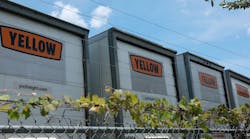The demise this month of nearly century-old Yellow Corp., once a titan of the industry's less-than-truckload sector, brought on many opportunities for others in the LTL space. Rivals such as XPO, Old Dominion Freight Line, and Saia already reported shipment increases attributable to Yellow's exit. But where do smaller fleets and owner-operators come into play in this reshuffled marketplace? Can smaller fleets help fill the gaping hole in the industry?
Now is the perfect opportunity for smaller trucking companies to grow their businesses, Kevin Abramson, president of Cover Whale, a commercial trucking insurance provider, told FleetOwner. He said that the technology available today benefits fleet owner-operators or even those who want to go out on their own, and the increase in potential business these players can get from Yellow's downfall isn't something smaller fleets should ignore.
See also: Yellow's exit 'reshuffling' the LTL deck
Abramson said that over the last decade, there's been an influx of owner-operators in the industry. Of course, that number grew in 2020 with the boom in freight rates during the pandemic. However, in recent months, there's been a decrease in owner-operator growth and record contraction due to factors such as a slumping spot market for freight and record-high fuel prices.
Ramandeep Singh Jhajj, an owner-operator with JB Transports, a trucking company that employs three trucks and trailers that haul freight in lanes in the Midwest, described these woes to FleetOwner.
"Business has been slow since the last quarter of 2022, and in recent years, the equipment prices have gone so high," Jhajj said. "High-interest rates also make it difficult to add trucks to the fleet, and spiked diesel prices resulted in a shrink in profit margins."
Abramson said these problems have even forced some of those who've ventured out on their own to return to working for a larger company.
See also: Exodus of fleets reaches historic levels in Q1, U.S. data shows
Those who continue to operate as carrier-dedicated owner-operators, however, should continue doing so, Abramson emphasized. Those interested in becoming their own boss can take advantage of the Yellow exit to start a business and ensure some sustainability in shipping customers.
What small fleets can do to be more attractive to shippers
Shippers that need carriers after Yellow's exit might be hesitant to employ a smaller fleet to handle their shipments, but Abramson told FleetOwner there is an opportunity for these small fleets to prove themselves. There are things fleet owner-operators can do that will help secure a position for them in the market.
As a first step, having vehicles on the road indicates reliability. For example, a large fleet of 500 trucks won't miss that one truck in the shop as significantly as a small fleet of two to four trucks. Small fleets that experience a three-week downtime while a truck is repaired from a fender bender could potentially go out of business.
See also: Three ways small fleets can stay competitive
To ensure the truck is on the road, the fleet must employ safe drivers and safety technology. This safety technology will also help drivers maintain a clean driving record, which Abramson said will be most attractive to shipping partners.
"Nobody wants to have an accident where freight's on the back of a truck and all of a sudden … it's completely wrecked," Abramson said.
Seizing the opportunity
If Yellow had folded decades ago, Abramson said the larger fleets would have filled the void immediately. "They would have captured that market share. They would have essentially hired the good drivers out of the 30,000 employees and left others on the side. I think now it is a dynamic where that's still at play, and I'm sure larger, medium, but also smaller players are really trying to capitalize and take advantage."
However, Jhajj says it's challenging to go after Yellow's business directly because he gets his business from load boards. If shipments are coming onto the load board because of the incapacity of larger fleet companies, then JB Transports picks up the slack without knowing whether it was from a former Yellow customer.
Abramson's advice to small fleet owner-operators is to ask what the goal is for the future. With the opportunity left behind by Yellow, there's space for fleets to grow, and it's up to the fleet owner-operator to decide just how much. Taking on considerably more business requires a certain amount of risk, but Abramson said there are partners out there, such as Cover Whale, that can help get them started.
See also: Old Dominion jumps into Yellow bidding with $1.5B for terminals
Jhajj expressed a different sentiment, however.
"Definitely someone has to fill the void, but I don't think smaller companies, especially owner-operators, have the capacity to directly fill the void," he said.
On a brighter note, Jhajj said Yellow's exit will bring more loads to the load board, and owner-operators have "more opportunity to negotiate the better load price when there are less trucks in the market to cover the loads."
At the heart of this, Abramson said the trucking industry is at an inflection point. There is an opportunity for the industry to embrace all the facets of information technology, safety technology, telematics, data, and driver coaching to help fill the void Yellow left behind—and that shouldn’t be filled solely by the large fleets in the industry.




